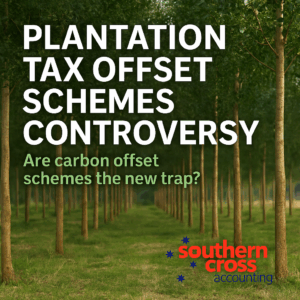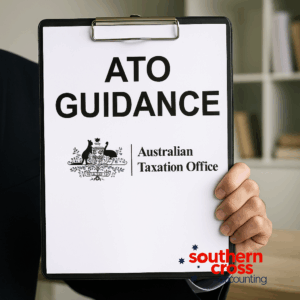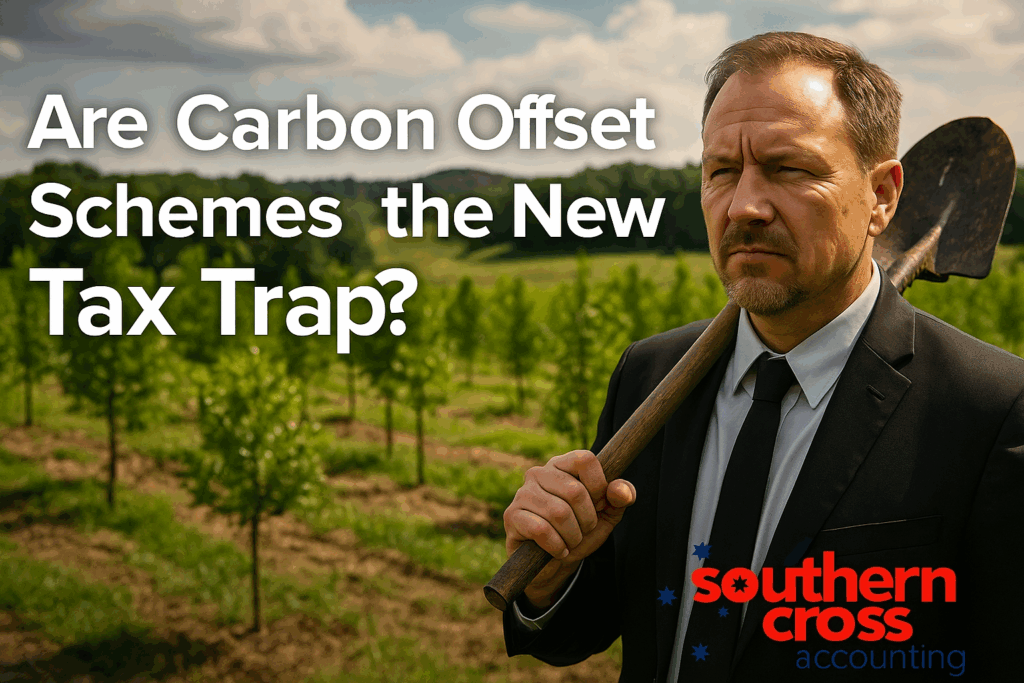Plantation & Tea Trees Schemes – Tax Offset Schemes
The Greenwashing of Tax Deductions
For decades, the Australian Taxation Office (ATO) has grappled with the fine line between genuine investment incentives and aggressive tax minimisation schemes.
One of the most striking examples of this tension came in the form of so-called “green” investments — Managed Investment Schemes (MIS) that promised significant tax offset schemes for planting tea trees, eucalyptus, and other commercial forestry assets [1].
These schemes appealed strongly to high-income earners and SME owners alike.
The opportunity to support environmental projects while reducing taxable income seemed almost too good to pass up. And in many cases, it was.
Despite their eco-conscious branding, a large proportion of these ventures ultimately collapsed.
The failed investments not only left many participants out of pocket but also subjected them to ATO disallowance of deductions and, in some instances, significant penalties and interest [3][4].
Today, as carbon credits and ESG-aligned deductions gain popularity, many business owners are asking:
Are we walking into another trap under the banner of sustainability?
This article revisits the plantation and tea tree investment debacle — not just to reflect on past mistakes, but to arm today’s small business owners with critical insights into the potential risks and red flags of modern-day tax offset schemes.

What Were the Plantation and Tea Tree Schemes?
From the mid-1990s through to the late 2000s, Australia experienced a surge in forestry-based Managed Investment Schemes (MIS).
Investors, including SME owners and high-income professionals — were invited to fund plantations of tea trees, sandalwood, eucalyptus, olives, and other lucrative crops.
These ventures were marketed as tax-saving opportunities via tax offset schemes [1].
Under the model, participants contributed to plantation establishment and maintenance costs and claimed immediate deductions against their taxable income.
Promoters emphasised environmental benefits, community development, and sustainable agriculture. The green narrative made the schemes appealing for both financial and ethical reasons.
However, in many instances, these ventures operated less like genuine agricultural enterprises and more like tax-driven financial products.
Promoters actively targeted SME owners and other taxpayers seeking to reduce end-of-year tax liabilities. The aggressive marketing campaign presented these deductions as a virtually risk-free strategy.
Beneath this façade, serious weaknesses emerged.
Many plantations were set up on marginal land with poor infrastructure and limited irrigation. Yield projections were frequently exaggerated or unreliable.
Promotional materials often downplayed agricultural performance in favour of tax incentives [2][3].
As momentum grew, it became apparent that the real profit for many promoters came from upfront investor fees — not from plantation profits.
Cash inflows from new investors were used to support existing commitments, resembling a Ponzi-like structure where genuine crop revenue played a negligible role.
When major operators like Timbercorp, Great Southern, and Rewards Group began collapsing, investors faced failed investments, and the ATO moved to confirm ATO disallowance of claimed deductions along with the imposition of penalties and interest [3][4][5].
The downfall of these schemes delivered a sobering lesson to SMEs: chasing upfront tax breaks without fully vetting the sustainability and regulatory compliance of the investment could lead to long-lasting financial and reputational damage.
The Tax Appeal: How They Promised Tax Deductions
A key driver behind the plantation MIS boom was the promise of substantial tax offset schemes upfront.
Under Division 394 of the Income Tax Assessment Act, investors, known as “initial participants” — could claim immediate deductions in the first year for significant establishment costs of the forestry investments [1].
Promotional materials touted that planting tea trees or sandalwood offered both environmental impact and immediate tax relief.
Many advertisements targeted SME owners and high-income earners approaching tax time, suggesting that investing in these green schemes could dramatically lower assessable income — often with little emphasis on agricultural viability or long-term returns [2].
The aggressive marketing was no accident. A government report noted that the structuring of these schemes was around claiming a tax benefit at the outset, with actual crop returns projected years later — if at all [2][6].
While “carbon sink” or “sustainable forestry” language featured prominently, the reality was quite different. Investigations revealed that a significant portion of investors’ contributions, often over 70% — did not go directly to forestry expenses as required by law, but instead funded promoters and administration overheads [1][2].
Moreover, risky land choices (like marginal soil or poor water access) were presented as sustainable plantations.
Yield assumptions were optimistic or unsupported by independent forestry analysis. Yet promotional pitches glossed over these risks, focusing solely on the immediate tax deductions.
In many cases, investors were left exposed. They had appealed to the tax offset schemes as a legal method to reduce their tax burden, only for the investments to deride as failed investments years later when actual harvest returns failed to materialise.
The final blow came when the ATO stepped in. In its reviews and audits, it assessed that many of these arrangements did not satisfy the genuine commercial intent required for deductions, leading to widespread ATO disallowance of previously claimed deductions — triggering reassessments with interest and, in some cases, penalties [3][4][6].
For SME business owners, the takeaway is clear: the allure of upfront tax offset schemes should never overshadow the foundational due diligence required to verify the commercial substance, forestry viability, and regulatory compliance of any such investment.
When It All Fell Apart: ATO Disallowance and Investor Fallout
By the late 2000s, cracks were showing. MIS promoters such as Timbercorp and Great Southern were collapsing under heavy debt and underwhelming output, and investors were left stranded with failed investments.
A glaring outcome was the ATO disallowance of the tax deductions that had initially attracted many to the schemes [7].
Timbercorp Collapse (2009)
Timbercorp, once Australia’s second‑largest MIS operator, entered voluntary administration in April 2009, burdened with $903 million in debt.
Subsequently, more than 14,000 investors were left heavily exposed, with KordaMentha revealing that many lost up to 80% of their initial investments [3][8].
Around 2,500 investors still faced bankruptcy from loans they took out to participate in the scheme [9].
Great Southern Collapse (2009)
Just weeks after Timbercorp’s failure, the Great Southern Group collapsed under $700 million in debt.
It had attracted nearly 43,000 investors and raised $1.8 billion, primarily through forestry and horticulture schemes that had been marketed aggressively for their “upfront link” to tax offset schemes [10].
In the aftermath, over 40,000 investors faced combined losses nearing $2 billion, with many receiving just a few cents in the dollar from a meagre class‑action settlement [4][11].
ATO Disallowance and Reassessments
In the wake of these collapses, the ATO launched broad reviews.
It concluded that many MIS arrangements did not meet the “genuine commercial purpose” test necessary for upfront deductions.
As a result, those who had claimed tax offset schemes faced reassessments that clawed back deductions, applied interest, and levied penalties [5][13].
This swift reversal transformed initial financial gains into substantial liabilities.
Regulatory Response
The national Senate Committee’s report “Bitter Harvest” (2016) identified troubling advice standards and systemic risks in MIS marketing.
It criticized financial advisers who prioritised commission over client suitability and called for stronger disclosure rules and oversight [6][12].

The Lessons for Today’s Business Owners
For SME owners, the rise and collapse of plantation-based Managed Investment Schemes (MIS) offer crucial insights into the risks of chasing deductions without sound commercial basis.
While the appeal of tax offset schemes remains strong, these past failures highlight the importance of scrutiny and scepticism.
Due Diligence Is Non-Negotiable
Before participating in any scheme claiming upfront tax advantages, business owners must verify:
- Land quality and agricultural viability, including rainfall, soil composition, and access to markets
- Scheme structure, especially that at least 70% of the funds go directly to project execution (as required under ATO guidelines for forestry deductions) [1][2]
Many failed investments collapsed because funds were instead diverted into marketing, commissions, and administrative overheads [2][5].
Understand What the ATO Allows
The ATO has clarified that deductions under Division 394 are only applicable where forestry MIS investments meet strict conditions of commercial purpose [1].
Schemes prioritising tax minimisation over yield were among those subjected to ATO disallowance and investor reassessments [2][11].
As of 2025, deductions for carbon sink forest expenses remain permitted, but only if they meet genuine environmental and sequestration purposes without commercial distortion [1].
Don’t Confuse Advice with Advocacy
Senate investigations found that financial advisers were incentivised by commissions, often prioritising sign-ups over client suitability [6][12].
SMEs should always seek truly independent tax and legal advice before entering any arrangement that markets tax savings.
Tax Deduction Is Not an Investment Return
One of the biggest traps for business owners was mistaking a tax deduction for financial gain.
Investors often focused on the short-term tax relief without understanding the viability of the business model or the long-term prospects of returns from harvest [3][4][10].
Stay Up to Date with ATO Signals
The ATO has since taken a strong compliance stance, supported by ASIC and the Senate’s Bitter Harvest report [4][6][13].
If your adviser or promoter is promising guaranteed deductions from any environmental or offset scheme, treat it as a red flag and refer to current ATO product rulings.
Are Carbon Tax Offset Schemes the New Trap?
With the increasing pressure on businesses to demonstrate environmental responsibility, a new breed of financial product has emerged: carbon offset schemes.
These initiatives promise to reduce your business’s carbon footprint, and sometimes, to reduce your tax bill as well.
But for Australian SMEs, the legacy of the plantation and tea tree schemes begs a serious question: Are these new offerings simply history repeating under a green veil?
Echoes of the Past
Just like the Managed Investment Schemes (MIS) of the 1990s and 2000s, carbon offset projects are often promoted with strong environmental narratives and upfront tax benefits.
But the Bitter Harvest report warned that tax concessions can distort commercial intent — leading to product structures built for deductions rather than outcomes [6][13].
Some modern offset projects are backed by solid science and accredited through Australian Carbon Credit Unit (ACCU) programs, but others operate in regulatory grey zones [14].
These programs may offer SMEs a deduction under the guise of carbon planting or sequestration—yet provide little transparency about where the funds go or whether the offsets are measurable and permanent.
The ATO’s Position
The ATO has maintained a cautious stance.
It allows deductions for carbon sink forest expenses under specific circumstances, such as land use change and long-term carbon sequestration intent.
However, the forestry must not be part of a scheme that focuses primarily on tax outcomes.
If the business purpose is unclear or incidental, the deduction may be disallowed under anti-avoidance provisions [1].
In this context, many so-called “green” schemes bear a troubling resemblance to past tax offset schemes disallowed in MIS arrangements.
The ATO now evaluates these projects not just on form, but on substance, drawing from lessons learned through its audits and enforcement actions during the MIS fallout [2][11].
Red Flags to Watch
SME owners should remain alert to the same hallmarks that foreshadowed the collapse of Timbercorp and Great Southern:
- Promised deductions without clarity on long-term commercial return
- Minimal detail on land use, permanence of offsets, or compliance frameworks
- High-pressure marketing strategies similar to those used by MIS advisers later found to have prioritised commissions over client interests [6][12]
If these factors exist in a carbon offset proposal, business owners should treat it not as a green innovation, but as a potential tax-time trap.
Proceed with Eyes Open
Carbon and environmental initiatives can play a legitimate role in a business’s ESG strategy.
But when pitched as a financial product designed to reduce tax, they deserve intense scrutiny.
As seen with previous failed investments, what begins as an appealing deduction can end in financial damage, reassessments, and ATO disallowance [3][5].

What the ATO Says Now About Tax Offset Schemes
In the wake of multiple high-profile failed investments, the ATO has become significantly more assertive in defining the boundaries of legitimate tax offset schemes.
For SMEs, understanding these boundaries is vital, not only to avoid unexpected tax reassessments but also to identify when an investment is truly compliant versus when it may be seen as a disguised tax minimisation structure.
The ATO’s Post-MIS Position
Following the collapse of schemes like Timbercorp and Great Southern, the ATO revised its guidance on what constitutes a valid deduction in investment contexts.
Deductions under Division 394 of the Income Tax Assessment Act are still permitted, but only where a scheme demonstrates genuine commercial purpose, proper application of funds, and long-term operational viability [1][2].
The ATO made it clear: deductions that are marketed primarily for tax benefit, with no real intent or capacity to generate income from the investment, are likely to be disallowed.
This position was reinforced by the findings of both the ANAO and the Senate’s Bitter Harvest inquiry [2][6][13].
Product Rulings and Warning Signs
To clarify what is and isn’t deductible, the ATO now issues Product Rulings.
These are public, binding determinations on whether the deductions promoted in a specific scheme will be honoured.
However, the existence of a product ruling does not guarantee that a scheme is free of risk.
The ATO may still review compliance, especially if:
- Contributions are diverted to promoters or marketing fees
- The arrangement offers guaranteed deductions irrespective of investment performance
- Income generation appears speculative or lacks substantiation
SMEs should never rely solely on the presence of a ruling. Instead, they should assess the full commercial substance of the arrangement and verify that any tax offset scheme complies with all eligibility criteria.
Avoiding ATO Disallowance: Red Flags
The ATO continues to highlight common features of schemes that may face disallowance, including:
- Loan arrangements that are non-recourse or artificially constructed to inflate deductions
- Misleading promotional material exaggerating returns or downplaying compliance obligations
- Carbon offset schemes where the offset generation or permanence cannot be independently verified [1][14]
If an offer includes these elements, it may be subject to ATO scrutiny and retrospective action.
Investors in the original MIS arrangements found themselves dealing with interest charges, amended assessments, and even penalties when deductions were denied years later [3][5][11].
The ATO’s Modern Approach: Transparency and Enforcement
The ATO’s current enforcement model focuses on:
- Real-time monitoring of promoted arrangements and mass-marketed tax schemes
- Promoter penalty laws, which allow the ATO to pursue individuals and entities that market or implement abusive tax schemes
- Data-matching and third-party reporting to cross-reference claims with actual environmental or agricultural performance
This approach ensures that schemes built to exploit gaps in regulation, or those operating in so-called “greenwashing” zones—are more likely than ever to be caught and disallowed [6][12][14].
How to Protect Yourself: A Practical Guide for SMEs
For small to medium-sized businesses in Australia, navigating tax offset schemes can be a minefield.
While there are still legitimate opportunities available, the line between genuine tax planning and risky arrangements has never been more closely scrutinised.
The collapse of plantation MIS, subsequent ATO disallowance, and today’s evolving green finance space offer a clear message: proceed with caution, not complacency.
Ask the Right Questions Before Investing
Before entering any scheme offering a tax benefit, SMEs should critically assess:
- What is the actual source of revenue? If returns rely solely on future investors or speculative resale, be cautious.
- Where is your money really going? Ensure the majority is allocated to productive or operational costs—not commissions, legal structures, or marketing [2][5].
- Is this scheme prioritising tax over returns? If tax savings are the central pitch, that’s a red flag.
Request detailed financial projections, land use evidence (for carbon or forestry schemes), and compliance reports.
Demand Independent Advice
Avoid relying solely on the adviser or promoter of the scheme. Seek independent professional advice from:
- A registered tax agent or accountant
- A solicitor familiar with investment law
- A financial adviser not earning a commission from the scheme
The Bitter Harvest report found widespread issues with advisers promoting MIS for financial gain without proper risk disclosures to clients [6][12].
Independent guidance may cost more upfront, but it’s far cheaper than facing reassessments or penalties down the track.
Verify Product Rulings—but Don’t Assume Safety
The ATO issues Product Rulings as public advice on specific tax arrangements. While useful, they are not a blanket assurance of legitimacy.
A scheme may still be disallowed if:
- Actual implementation varies from the ruling’s assumptions
- The ATO identifies abuse of structure or intent
- The scheme fails to meet thresholds for commercial viability [1][13]
Cross-check the ruling against actual practice and ask whether the facts on the ground match what was reviewed.
Consider the Long-Term Tax Impact
Many SME investors in MIS were surprised to face ATO reassessments up to five years later, with interest and penalties compounding their original tax bill [3][11].
Before participating in any offset or deduction-based scheme, ask:
- What happens if this deduction is denied later?
- Can your business handle a large backdated liability?
If the scheme includes loans or deferred payment options, this risk increases significantly.
Prioritise Transparency and Accreditation
If considering carbon or environmental schemes, look for:
- Registration under the Australian Carbon Credit Unit (ACCU) Scheme
- Transparent reporting and third-party validation of offsets
- Clarity on who owns the carbon rights and how permanence is guaranteed [14]
The Department of Climate Change has made efforts to clean up the sector, but “grey zone” operators still exist.
Only schemes with clear governance, permanence, and traceable credits should be considered for any business with long-term compliance in mind.
Keep Tax Planning Grounded in Commercial Reality
Legitimate tax offset schemes should be the by-product of sound investment decisions — not the core motivator.
If a scheme cannot stand on its commercial or operational merits alone, it likely cannot withstand ATO scrutiny.
As ASIC and the ATO continue to prioritise enforcement actions against mass-marketed schemes, SMEs must remember: no tax deduction is worth the risk of litigation, reputational damage, or financial collapse [4][6][14].

Conclusion: Are Carbon Offset Schemes the New Trap?
History rarely repeats—but in taxation, it often rhymes.
The collapse of plantation-based tax offset schemes like Timbercorp and Great Southern left thousands of Australian investors exposed, with ATO disallowance, mounting debts, and little to no return.
What began as environmentally framed, deduction-heavy investments devolved into failed investments with far-reaching consequences.
Today, many of the same ingredients are resurfacing—this time, under the banner of carbon.
From reforestation ventures to biodiversity corridors, SMEs are once again being offered schemes that promise to shrink their tax bill while improving their sustainability credentials.
The question every business owner should now be asking is this:
Are carbon offset schemes the next tax-time trap?
There’s no doubt that many programs registered under the Australian Carbon Credit Unit (ACCU) framework are credible and science-backed. But even the Department of Climate Change acknowledges the need for greater transparency, stronger governance, and better public clarity across the offset landscape [14].
As in the MIS era, not all offerings are equal — and some may be built more for compliance arbitrage than for climate action.
The ATO has already signalled it won’t tolerate history repeating.
Deduction eligibility now depends not just on documentation, but on clear commercial purpose, tangible outcomes, and consistency with public rulings [1][6].
The presence of a carbon narrative is no longer enough. The substance of the scheme must match the story.
For SMEs, the lesson is straightforward: approach every tax-advantaged scheme with informed scepticism.
Do not accept glossy brochures or ESG buzzwords in place of operational detail. Validate the offset, the accreditation, and the cash flow model. And most importantly, engage independent advisers before signing or claiming anything.
The plantation schemes of the past taught us that when tax becomes the product, business owners become the risk.
In 2025, the language may be different — “sustainability” instead of “forestry”, but the structure of the trap may be much the same.
Be green. Be smart. But above all, be careful.
References and Sources:
- Australian Taxation Office. Forestry managed investment schemes (Division 394). Last updated 31 Jul 2017.
https://www.ato.gov.au/about-ato/ato-advice-and-guidance/in-detail/information-for-product-rulings-applicants/forestry-managed-investment-schemes - Australian National Audit Office. ATO’s Management of Aggressive Tax Planning (2003–04).
https://www.anao.gov.au/sites/default/files/anao_report_2003-2004_23.pdf - ABC News. Losing billions in agricultural MIS projects. Published 21 Dec 2012.
https://www.abc.net.au/news/rural/2012-12-21/losing-billions-in-agricultural-mis-projects/6151334 abc.net.au+9abc.net.au+9dolmanbateman.com.au+9abc.net.au+2crikey.com.au+2smartcompany.com.au+2en.wikipedia.orgaph.gov.au+1ato.gov.au+1 - ABC News. Great Southern investors challenging tiny settlement. Published 5 Nov 2014.
https://www.abc.net.au/news/2014-11-05/great-southern-investors-challenging-tiny-settlement/5867412 abc.net.au+1en.wikipedia.org+1 - Crikey. Liquidator spills more beans on Timbercorp. Published 13 Oct 2010.
https://www.crikey.com.au/2010/10/13/liquidator-spills-more-beans-on-timbercorp/ smartcompany.com.au+4crikey.com.au+4abc.net.au+4 - Senate Economics References Committee. Agribusiness managed investment schemes: Bitter harvest. March 2016.
https://www.aph.gov.au/parliamentary_business/committees/senate/economics/mis/~/media/Committees/economics_ctte/MIS/Report/b03.pdf ato.gov.au+5ifa.com.au+5en.wikipedia.org+5aph.gov.au - Timbercorp (Wikipedia). Timbercorp – MIS history and collapse. Accessed June 2025.
https://en.wikipedia.org/wiki/Timbercorp afr.com+9en.wikipedia.org+9abc.net.au+9 - Australian Financial Review. Managed investment scheme giant Great Southern collapses. May 2009.
https://www.smartcompany.com.au/finance/20090518-managed-investment-scheme-giant-great-southern-collapses/ moneymanagement.com.au+10smartcompany.com.au+10en.wikipedia.org+10 - ABC News. Liquidators chase debts from mum and dad investors in failed Timbercorp. Published 18 May 2015.
https://www.abc.net.au/news/rural/2015-05-18/mis-timbercorp-bankruptcies-compound-investor-woes/6478158 abc.net.au+1ifa.com.au+1 - Australian Financial Review. Great Southern felled under $700m debt. Published May 2009.
https://www.afr.com/companies/agriculture/great-southern-felled-under-700m-debt-20090518-jmucv afr.com+1smartcompany.com.au+1 - Australian National Audit Office. See Ref. 2 above. (Cited re ATO ruling)
- Crikey / IFA summary. “Horrifying” advice played role in MIS collapses: Senate. Published 2015.
https://www.ifa.com.au/news/15862-horrifying-advice-played-role-in-mis-collapses-senate aph.gov.au+1dolmanbateman.com.au+1en.wikipedia.org+2ifa.com.au+2afr.com+2 - Senate report. See Ref. 6 above (detailed on ATO reassessments)
- Department of Climate Change, Energy, the Enviroment and Water. Australian Carbon Credit Unit (ACCU) Scheme. https://www.dcceew.gov.au/climate-change/emissions-reduction/accu-scheme
Contents
- 1 Plantation & Tea Trees Schemes – Tax Offset Schemes
- 2 The Greenwashing of Tax Deductions
- 3 What Were the Plantation and Tea Tree Schemes?
- 4 The Tax Appeal: How They Promised Tax Deductions
- 5 When It All Fell Apart: ATO Disallowance and Investor Fallout
- 6 The Lessons for Today’s Business Owners
- 7 Are Carbon Tax Offset Schemes the New Trap?
- 8 What the ATO Says Now About Tax Offset Schemes
- 9 How to Protect Yourself: A Practical Guide for SMEs
- 10 Conclusion: Are Carbon Offset Schemes the New Trap?

